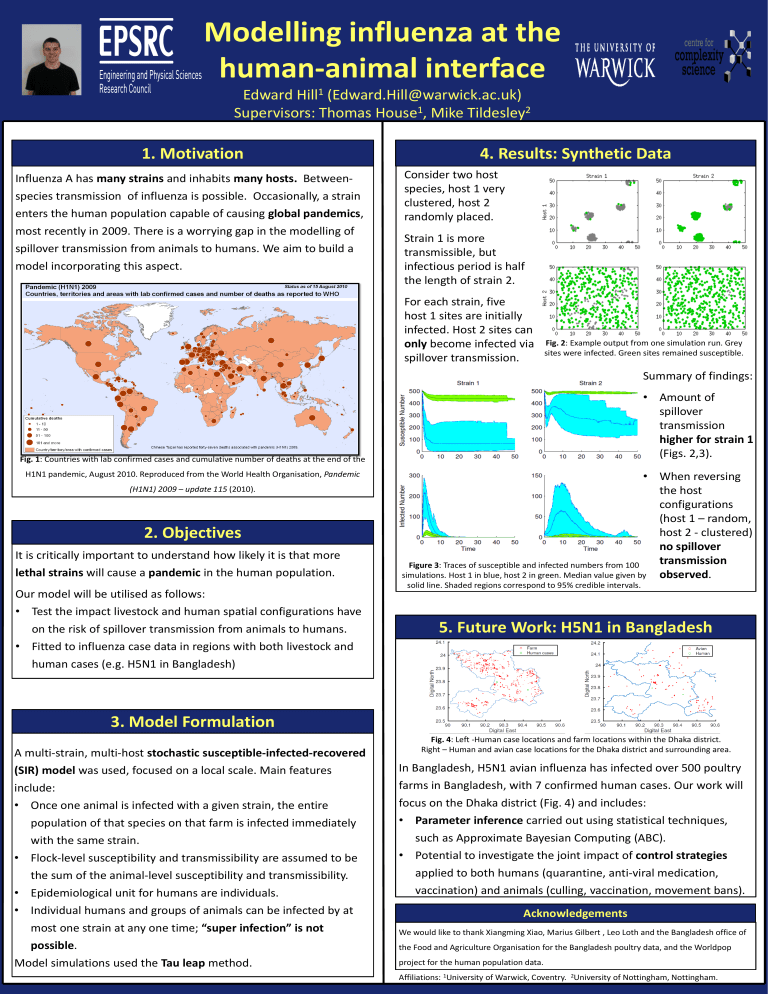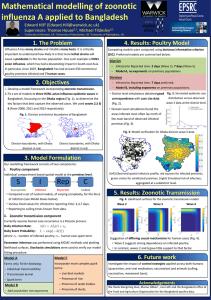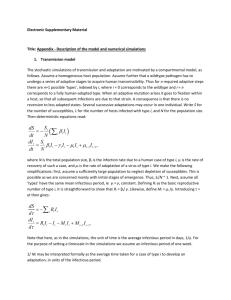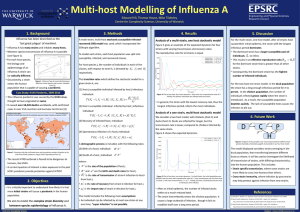Modelling influenza at the human-animal interface 1. Motivation

Figure 1 : Influenza Type A transmitted between different animal species and humans. Adapted from [1].
Figure 2 : Countries with lab confirmed cases and cumulative number of deaths as reported by WHO at the end of the H1N1 pandemic, August 2010. Reproduced from [3].
Modelling influenza at the human-animal interface
Edward Hill
1
(Edward.Hill@warwick.ac.uk)
Supervisors: Thomas House
1
, Mike Tildesley
2
1. Motivation
Influenza A has many strains and inhabits many hosts. Betweenspecies transmission of influenza is possible. Occasionally, a strain enters the human population capable of causing global pandemics , most recently in 2009. There is a worrying gap in the modelling of spillover transmission from animals to humans. We aim to build a model incorporating this aspect.
Fig. 1 : Countries with lab confirmed cases and cumulative number of deaths at the end of the
H1N1 pandemic, August 2010. Reproduced from the World Health Organisation, Pandemic
(H1N1) 2009 – update 115 (2010).
4. Results: Synthetic Data
Consider two host species, host 1 very clustered, host 2 randomly placed.
Strain 1 is more transmissible, but infectious period is half the length of strain 2.
For each strain, five host 1 sites are initially infected. Host 2 sites can only become infected via spillover transmission.
Fig. 2 : Example output from one simulation run. Grey sites were infected. Green sites remained susceptible.
Figure 3 : Traces of susceptible and infected numbers from 100 simulations. Host 1 in blue, host 2 in green. Median value given by solid line. Shaded regions correspond to 95% credible intervals.
Summary of findings:
• Amount of spillover transmission higher for strain 1
(Figs. 2,3).
• When reversing the host configurations
(host 1 – random, host 2 - clustered) no spillover transmission observed .
2. Objectives
It is critically important to understand how likely it is that more lethal strains will cause a pandemic in the human population.
Our model will be utilised as follows:
• Test the impact livestock and human spatial configurations have on the risk of spillover transmission from animals to humans.
• Fitted to influenza case data in regions with both livestock and human cases (e.g. H5N1 in Bangladesh)
3. Model Formulation
A multi-strain, multi-host stochastic susceptible-infected-recovered
(SIR) model was used, focused on a local scale. Main features include:
• Once one animal is infected with a given strain, the entire population of that species on that farm is infected immediately with the same strain.
• Flock-level susceptibility and transmissibility are assumed to be the sum of the animal-level susceptibility and transmissibility.
• Epidemiological unit for humans are individuals.
• Individual humans and groups of animals can be infected by at most one strain at any one time; “super infection” is not possible .
Model simulations used the Tau leap method.
5. Future Work: H5N1 in Bangladesh
Fig. 4 : Left -Human case locations and farm locations within the Dhaka district.
Right – Human and avian case locations for the Dhaka district and surrounding area.
In Bangladesh, H5N1 avian influenza has infected over 500 poultry farms in Bangladesh, with 7 confirmed human cases. Our work will focus on the Dhaka district (Fig. 4) and includes:
• Parameter inference carried out using statistical techniques, such as Approximate Bayesian Computing (ABC).
• Potential to investigate the joint impact of control strategies applied to both humans (quarantine, anti-viral medication, vaccination) and animals (culling, vaccination, movement bans).
Acknowledgements
We would like to thank Xiangming Xiao, Marius Gilbert , Leo Loth and the Bangladesh office of the Food and Agriculture Organisation for the Bangladesh poultry data, and the Worldpop project for the human population data.
Affiliations: 1 University of Warwick, Coventry. 2 University of Nottingham, Nottingham.
D C P
H
Figure 5 : Diagram of the possible cross-transmission between different host species (ducks(D), chickens(C), pigs(P), humans(H)) in our four host model.






